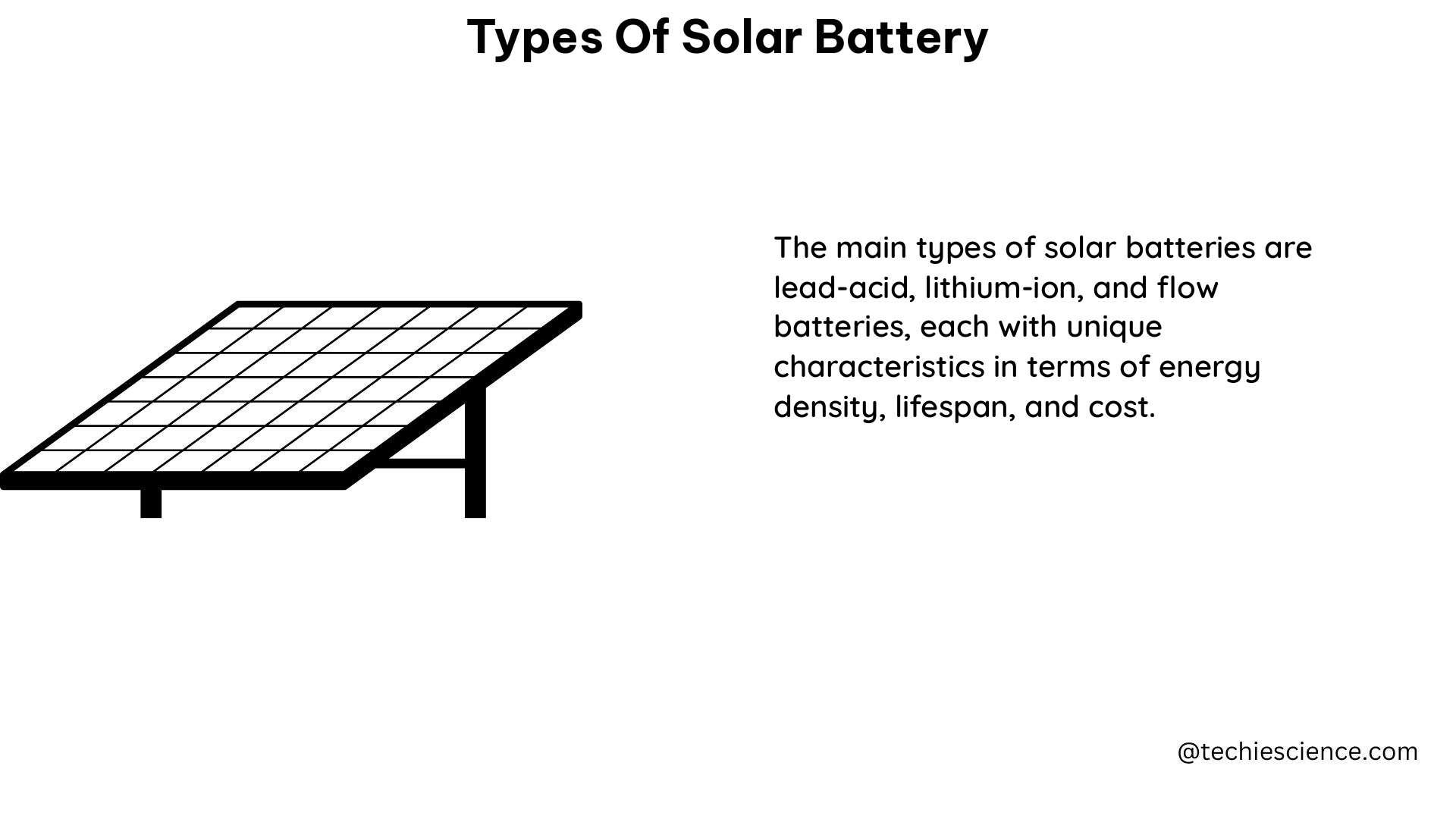Solar batteries are an essential component of any solar energy system, providing a reliable and efficient way to store the energy generated by solar panels. With a wide range of options available, it’s crucial to understand the different types of solar batteries and their unique characteristics to make an informed decision. In this comprehensive guide, we’ll explore the four main types of solar batteries, their features, and the factors to consider when selecting the right one for your needs.
Lead Acid Batteries
Lead acid batteries are one of the most widely used types of solar batteries, known for their affordability and reliability. These batteries come in two main varieties: flooded lead acid and sealed lead acid.
Flooded Lead Acid Batteries:
– Capacity: Typically range from 100 Ah to 3000 Ah, with higher capacities suitable for larger solar energy systems.
– Power: Typically range from 100 W to 3000 W, depending on the battery size and configuration.
– Depth of Discharge (DoD): Typically around 50%, meaning they should not be discharged below 50% of their total capacity to maintain optimal performance and lifespan.
– Round-Trip Efficiency: Around 85%, which means that 85% of the energy stored in the battery can be retrieved for use.
– Battery Life and Warranty: Typically last 5-10 years, with warranties varying based on the manufacturer.
Sealed Lead Acid Batteries:
– Capacity: Similar to flooded lead acid batteries, ranging from 100 Ah to 3000 Ah.
– Power: Typically range from 100 W to 3000 W.
– Depth of Discharge (DoD): Typically around 80%, allowing for deeper discharges compared to flooded lead acid batteries.
– Round-Trip Efficiency: Around 90%, slightly higher than flooded lead acid batteries.
– Battery Life and Warranty: Typically last 3-5 years, with warranties varying based on the manufacturer.
Lithium-Ion Batteries

Lithium-ion batteries have gained popularity in recent years due to their high energy density, long lifespan, and efficient performance. These batteries are commonly used in a variety of applications, including solar energy storage.
- Capacity: Typically range from 3.3 kWh to 13.5 kWh, making them suitable for a wide range of solar energy systems.
- Power: Typically range from 3.3 kW to 7 kW, providing ample power for most residential and small-scale commercial solar installations.
- Depth of Discharge (DoD): Typically around 90%, allowing for deeper discharges without compromising the battery’s lifespan.
- Round-Trip Efficiency: Around 95%, making them one of the most efficient solar battery options.
- Battery Life and Warranty: Typically last around 10 years, with warranties varying based on the manufacturer.
Nickel-Based Batteries
Nickel-based batteries, such as nickel-cadmium (NiCd) and nickel-metal hydride (NiMH), are another option for solar energy storage. While not as widely used as lead acid or lithium-ion batteries, they offer some unique characteristics.
- Capacity: Typically range from 1.2 kWh to 4 kWh, making them suitable for smaller solar energy systems.
- Power: Typically range from 1.2 kW to 4 kW, providing adequate power for most residential and small-scale applications.
- Depth of Discharge (DoD): Typically around 80%, allowing for deeper discharges compared to lead acid batteries.
- Round-Trip Efficiency: Around 80%, which is lower than lithium-ion and some lead acid battery types.
- Battery Life and Warranty: Typically last 5-10 years, with warranties varying based on the manufacturer.
Flow Batteries
Flow batteries, also known as redox flow batteries, are a relatively new and innovative type of solar battery. These batteries use a liquid electrolyte solution to store and release energy, offering some unique advantages.
- Capacity: Typically range from 2 kWh to 100 kWh, making them suitable for a wide range of solar energy system sizes.
- Power: Typically range from 2 kW to 100 kW, providing ample power for large-scale solar installations.
- Depth of Discharge (DoD): Typically around 100%, allowing for complete discharge without compromising the battery’s lifespan.
- Round-Trip Efficiency: Around 75%, which is lower than some other battery types but still relatively efficient.
- Battery Life and Warranty: Typically last 10-20 years, with warranties varying based on the manufacturer.
When selecting a solar battery, it’s essential to consider factors such as capacity, power, depth of discharge, round-trip efficiency, battery life, and warranty, as well as compatibility with your existing solar panel system and inverter. Additionally, safety features, such as thermal management and overcharge/overdischarge protection, should be taken into account to ensure the long-term reliability and performance of your solar energy storage system.
References:
– Solar Reviews – Types of Solar Batteries
– Franklin W. Holley – Choosing the Right Size and Capacity for a Solar Battery System
– SolarEdge – How to Select the Right Solar Energy Battery Storage for Your Needs

The lambdageeks.com Core SME Team is a group of experienced subject matter experts from diverse scientific and technical fields including Physics, Chemistry, Technology,Electronics & Electrical Engineering, Automotive, Mechanical Engineering. Our team collaborates to create high-quality, well-researched articles on a wide range of science and technology topics for the lambdageeks.com website.
All Our Senior SME are having more than 7 Years of experience in the respective fields . They are either Working Industry Professionals or assocaited With different Universities. Refer Our Authors Page to get to know About our Core SMEs.